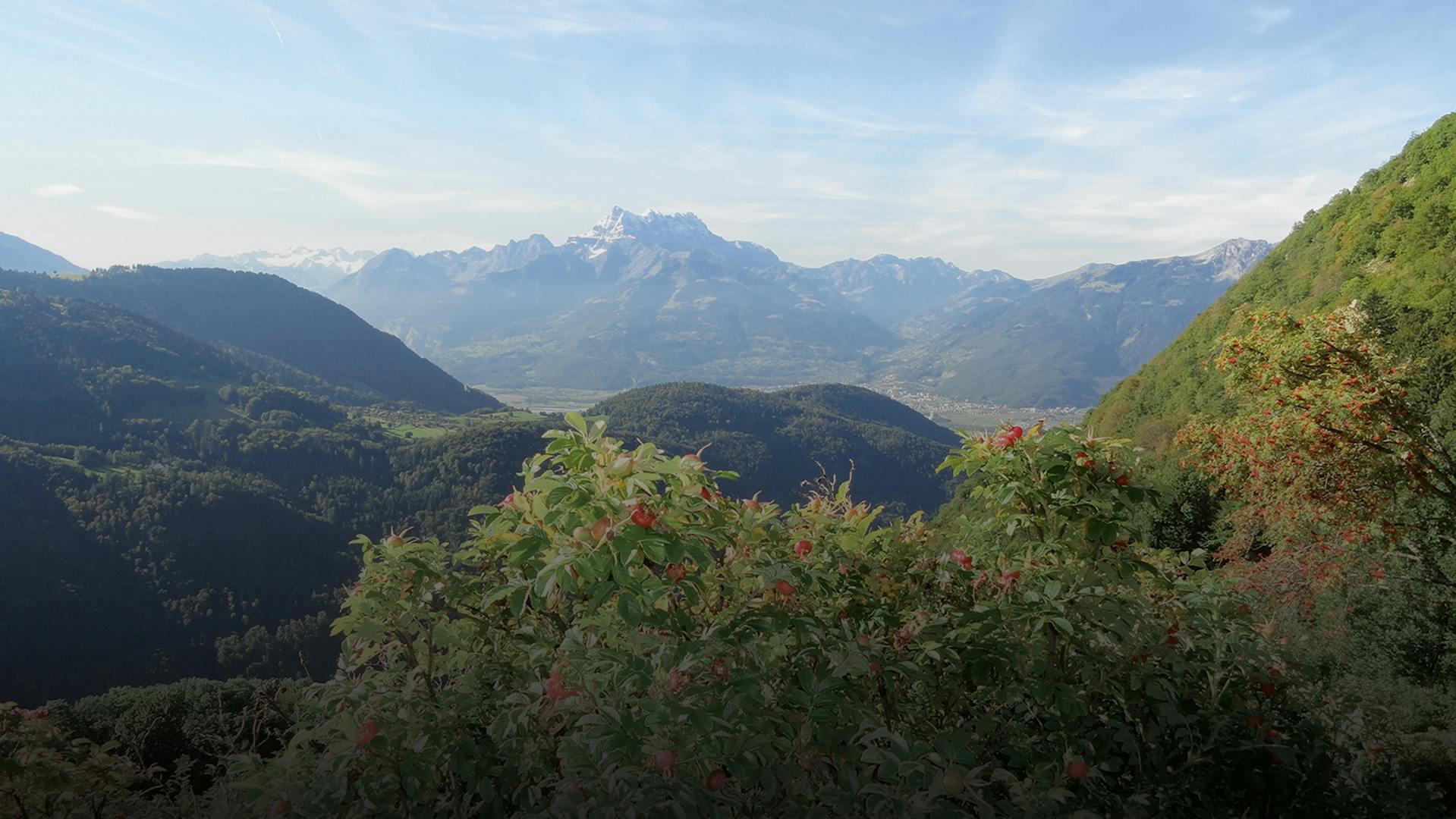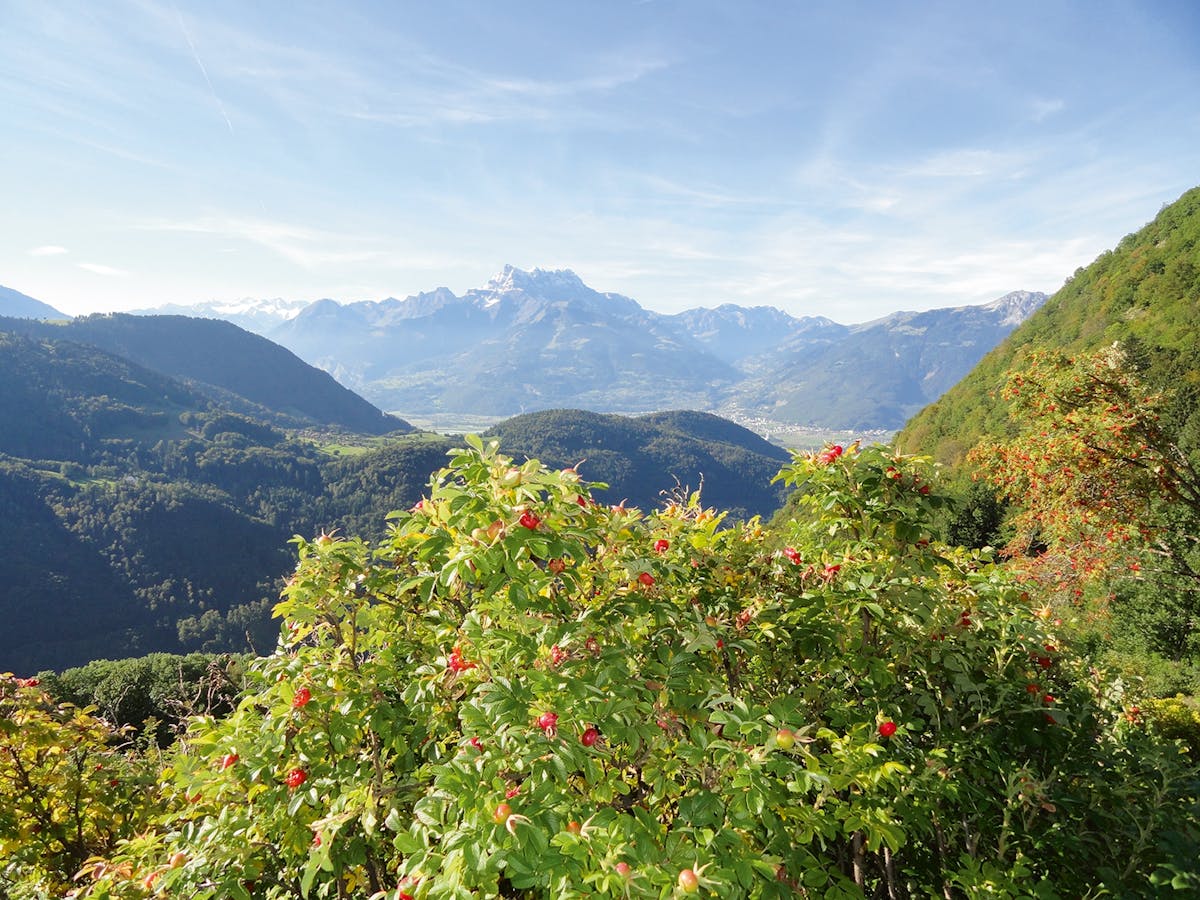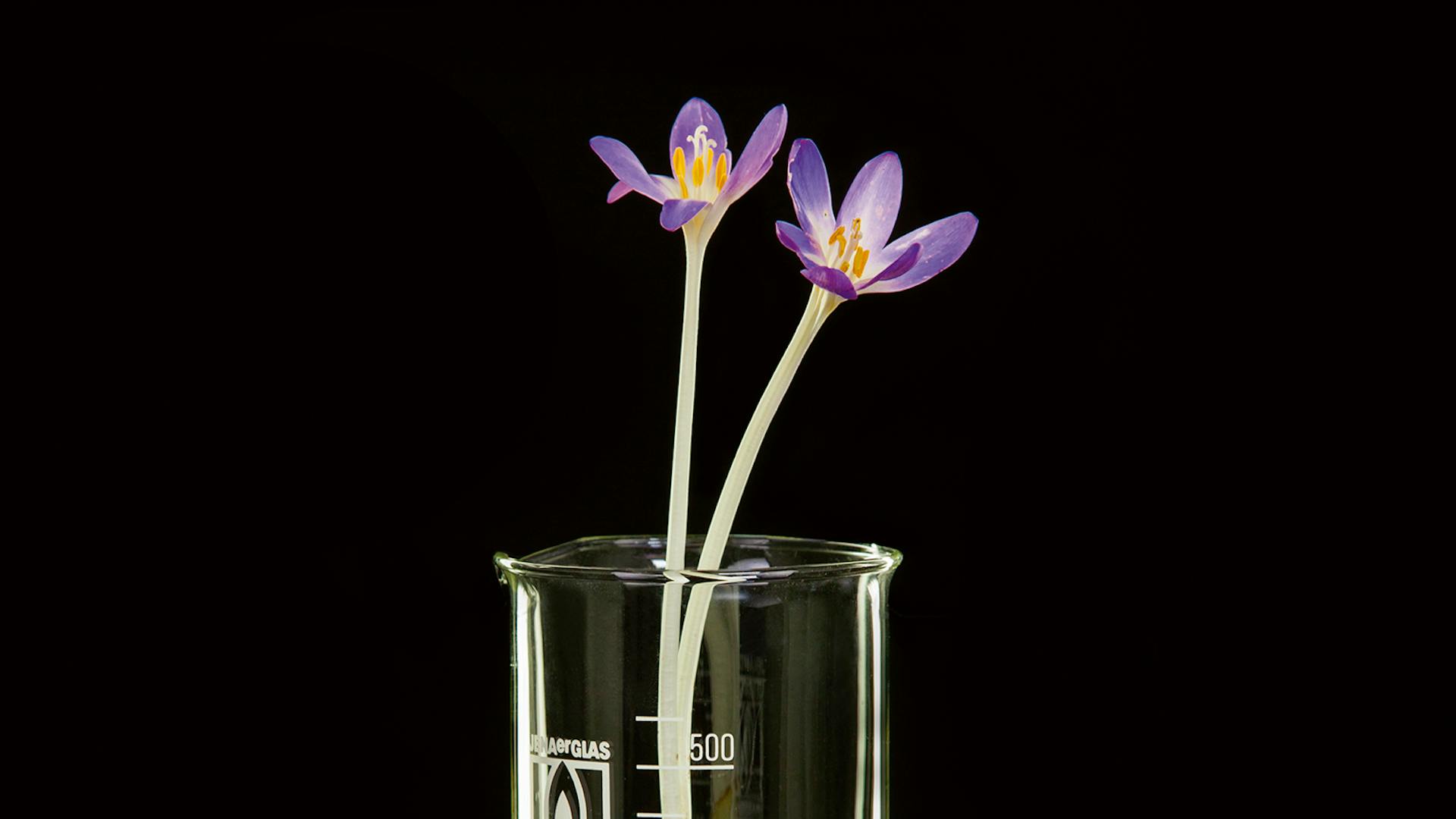
A spectacular view over the Valais Alps as seen from the Gentiana medicinal plant garden in Leysin.
This article was originally published in April 2014.
Published on 01/06/2020
With the rediscovery of the healing power of plants in the manufacture of drugs and remedies, the Gentiana medicinal plant garden in Leysin has become the focus of increased attention. The garden is planted at an altitude of 1100 meters above sea level, planted on a sunny terrace above the plains of the Rhone River. Visitors not only experience a unique garden with a variety of more than a thousand medicinal plants. They also learn a great deal about the characteristics, uses and risks of herbs, berries and roots.
Herb gardens have a long history that goes back to the Middle Ages. They were cultivated and cared for especially by monasteries, convents and royal estates. Back then, plants were grown primarily for cooking. But even in those past times, medicinal herbs, or at least a belief in their healing powers, played an important role. Wildegg Castle in the Canton of Aargau, for example, is home to a particularly beautiful herb garden. The botanical garden in Leysin, however, with its medicinal plants is unique in Switzerland and is taking on increasing importance due to the growing demand for natural ingredients, which are becoming more and more popular among the public at large.
“The last plant that was registered as a medication at Swiss-medic is golden root, also known as rose root. That was roughly two and a half years ago,” explains Kurt Hostettmann, president of the Gentiana Foundation. “It is prescribed to people who suffer from stress.” The professor emeritus, standing in his garden and pointing to a golden root, is clearly in his element. For 24 years he taught pharmacognosy and phytochemistry at the University of Lausanne, and for another five years at the University of Geneva after the department was transferred there.
“People became familiar with golden root following its use by physicians in the Soviet Army around 1979. During the war in Afghanistan, they gave soldiers roots of this plant to chew on to combat anxiety, fatigue and stress,” explains Hostettmann. Since then, a huge market has grown for this yellow plant, especially since topics such as burnout and stress have become more prominent in our society. Hostettmann emphasizes that it takes a great deal of effort before Swissmedic, the Swiss agency for therapeutic products, places a medication on its list of approved products. High requirements must be met in terms of quality, safety and efficacy.
Hostettmann has been retired for five years. Despite this, medicinal plants still remain his life and passion. A while back, he completed his studies in chemistry at the University of Neuchâtel with a dissertation about the substances in gentians. It therefore comes as no surprise that he named his foundation after this plant. Some 40 species of gentians bloom in the medicinal plant garden and there are approximately 400 different species around the world.
Enlightenment and relaxation
A native of Biel/Bienne, the professor is a wonderful story teller and his words bubble with enthusiasm in both French and German.
“The ancient Greeks rubbed rosemary on their children’s temples and foreheads to make them more intelligent.” He then points out that we have since rediscovered rosemary as a medicinal product. Two years ago, a study conducted in the United Kingdom was published in a large pharmacology magazine in the United States. Its core statement was that during neuropsychological tests with students, those who did best had a higher concentration of substances from rosemary in their blood. And Hostettmann also points out that “residents of retirement homes in the U.S. inhale rosemary oil to prevent Alzheimer’s disease.” Visitors meander on the carefully swept gravel paths, moving from one group of plants to the next. There are 15 different sectors to the garden. Plants are grouped and cultivated according to their therapeutic indications, and every plant bed is labeled with a clear, easy-to-read plaque. There are groups with plants for preventing cancer, plants for the heart, plants to fight pain or colds and flu, plants for women, and plants that work as laxatives.
A special group is devoted to poisonous plants. As Hostettmann says, “Many people believe that everything that grows in nature is good. That’s clearly wrong. We want to warn our visitors about those plants they should make absolutely sure to avoid. There are not only healing plants, but also plants that are poisonous to humans.”
To demonstrate this fact, he brings out some photos showing the arms, hands and upper bodies of people whose skin has in some cases been severely burned. He then plucks a Euphorbia bud, slits it open with his pocket knife and presses out the white juice. “This juice is poisonous and can severely damage your hands.” Other plants are labeled as ranging from highly toxic to lethal. They include blue and yellow Aconitum (aconite or monkshood), Daphne mezereum (mezereon), Digitalis purpurea (foxglove) and the Colchicum autumnale (autumn crocus or meadow saffron).
There are other plants found growing in forests or meadows that are often mistakenly identified. While their effects might be less dramatic, they are still not harmless. For instance, the leaves of lily of the valley look similar to those of wild garlic. However, when preparing a salad, you certainly do not want to get them mixed up because lily of the valley is highly poisonous. Hostettmann also dispels the myth that orchid bulbs, whose shape resembles testicles, can enhance virility when crushed into a powder. Instead, he says, it is much more effective to drink two deciliters of pomegranate concentrate because this can increase the level of testosterone in the saliva by as much as 20 percent.
The Alpine plants thrive on the sunny, chalky stone, in wet and dry areas, between broad-leafed deciduous trees and woodland groves. Visitors can admire plants rarely found in Switzerland, e.g. from the Himalayas, the Caucasus and the U.S. Even the ginkgo tree grows well in a mountainous climate, and Hostettmann devotes special attention to it. Extracts from the specially shaped leaves have a positive effect on cognitive performance, promote the ability to concentrate and improve blood flow to the brain. The professor is convinced that these plants could also gain in importance for the prevention of Alzheimer’s.
A reawakening at Leysin
But what exactly gave him the idea of creating this garden? Leysin was once known as a mountain clinic for tuberculosis patients. In the early 20th century, it was home to a number of famous sanatoria. “The end of that era began with the discovery of antibiotics,” explains Hostettmann. “From that time on, there was an effective treatment for pulmonary diseases. The sanatoria were closed, and Leysin as a health resort went into decline.”
Leysin established itself as a winter sports resort, but in summer there are only few visitors. Former mayor Maurice Besse therefore came up with the idea of creating a botanical garden similar to the one that had graced Leysin in the previous century. When he received Besse’s request, Hostettmann initially declined because there were already several botanical gardens in Valais and Vaud. “It didn’t make any sense. Instead I uggested creating a garden for medicinal plants that placed a focus on personal health and well-being. That fits in well with Leysin.”
As a result, the Gentiana Foundation was established in 2002. The community gave it an ideal location, facing south and protected from the wind. Hostettmann created the garden with the financial support of the Community of Leysin, the Loterie Romandie, the Sandoz Family Foundation, various pharmaceutical companies and private sponsors. The property is roughly 30 000 square meters in size. The garden is currently planted on 6000 square meters and was opened in 2004. At the entrance a simple, old chalet protects the gardeners against the elements and also houses a small shop.
Maintaining the garden costs approximately 50 000 Swiss francs per year. Hostettmann makes no secret of the fact that financial support for the Gentiana garden has already been endangered in the past and that there was even the risk of its closure. “We not only have perennials but also many species that have to be replanted every year. This involves a great deal of expense.”
The garden is celebrating its 10th anniversary this year, and the tireless professor is planning new projects. He would like to group the plants in the garden according to their families and in so doing make it possible to identify the affinities between them that are not obvious at first glance, such as the wide variety and importance of Solanaceae (nightshades).










